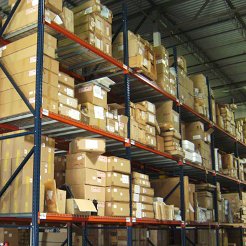
The definition of material handling equipment is equipment that is related to the movement, storage, control and protection of materials, goods and products throughout the process of manufacturing, distribution, consumption and disposal. Consequently, because material handling equipment is so vital to all stages of production and consumption, business owners and managers are always seeking ways to increase output, control costs, and maximize productivity. In other words, the three vital aspects to whether material handling equipment is achieving peak efficiency or not.
Material handling equipment is divided into four categories:
1. Storage and Handling Equipment
2. Engineered Systems
3. Industrial Trucks
4. Material Handling
Storage and Handling Equipment
Pallet racking, shelving and carts, and other non-automated storage equipment falls under the category of storage and handling equipment. Also known as ‘catalog’ items, storage and handling equipment may be the most basic form yet universally used and accepted.
Engineered Systems
Opposite of storage and handling equipment, engineered systems are custom engineered products like conveyors, handling robots, AS/RS, AGV and other automated forms of handling and moving equipment.
Industrial Trucks
Any vehicle operated by an individual would fall under the category of industrial trucks whether powered manually, by gasoline, propane or electricity. Industrial trucks assist the material handling system and go where the engineered systems cannot.
Material Handling
Material handling in bulk, such as what you would find on a farm, falls under the category of material handling. The category is reserved for moving bulk material or liquid at a quick rate.
Determine Material Handling Equipment Efficiency
It all comes down to the three primary factors:
1. Increase Output
2. Control Costs
3. Maximize Productivity
The formula for achieving peak efficiency is not exactly stamped in gold. It all depends on your individual circumstances. Some major operations need help from all four categories of material handling equipment. Other, smaller operations are unable to afford engineered systems at the moment and therefore must rely on industrial trucks and material handling. Regardless of your situation, however, understanding the three components which guarantee peak efficiency will allow you to study production and find areas where the operation could be improved.
Achieving Peak Efficiency
The goal of any great company should be to always expand their operation and find ways to improve efficiency. If you share that same mindset, then you are already on the right track. Achieving peak efficiency with your material handling equipment is predicated on the simple formula:
Increase output + Control costs = Maximize productivity.
Find out in what areas you could improve output and then ask yourself the question ‘What will it take to increase production? Do I need more forklifts? Do I need more automated, engineered systems to assist with the manpower I already have delegated?’
Then, the question is, how do you control costs which are not just related to the new ways you plan to do business? Are you spending gas and salary on ten forklifts and operators when two automated handling robots could essentially be doing the same thing? While the costs would be higher upfront would I save money in the long-run? These are the type of questions you need to ask yourself when considering controlling costs.
Ask the tough questions and you will get the real answers. Don’t be afraid to challenge yourself and think outside the box; often it is these types of personalities who are able to achieve peak efficiency more than others.
